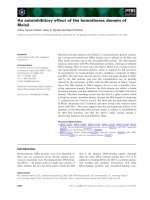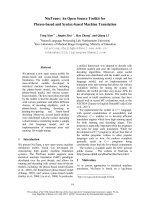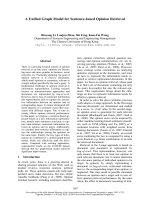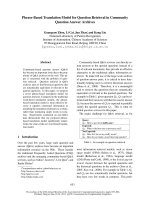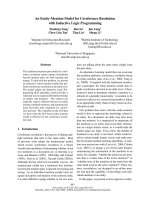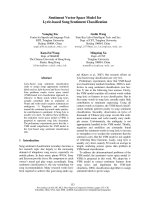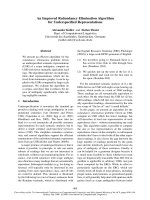Báo cáo khoa học: "An Improved Error Model for Noisy Channel Spelling Correction" ppt
Bạn đang xem bản rút gọn của tài liệu. Xem và tải ngay bản đầy đủ của tài liệu tại đây (71.1 KB, 8 trang )
An Improved Error Model for Noisy Channel Spelling Correction
Abstract
The noisy channel model has been applied
to a wide range of problems, including
spelling correction. These models consist
of two components: a source model and a
channel model. Very little research has
gone into improving the channel model
for spelling correction. This paper
describes a new channel model for
spelling correction, based on generic
string to string edits. Using this model
gives significant performance
improvements compared to previously
proposed models.
Introduction
The noisy channel model (Shannon 1948)
has been successfully applied to a wide
range of problems, including spelling
correction. These models consist of two
components: a source model and a channel
model. For many applications, people have
devoted considerable energy to improving
both components, with resulting
improvements in overall system accuracy.
However, relatively little research has gone
into improving the channel model for
spelling correction. This paper describes an
improvement to noisy channel spelling
correction via a more powerful model of
spelling errors, be they typing mistakes or
cognitive errors, than has previously been
employed. Our model works by learning
generic string to string edits, along with the
probabilities of each of these edits. This
more powerful model gives significant
improvements in accuracy over previous
approaches to noisy channel spelling
correction.
1 Noisy Channel Spelling Correction
This paper will address the problem of
automatically training a system to correct
generic single word spelling errors.
1
We do
not address the problem of correcting
specific word set confusions such as
{to,too,two} (see (Golding and Roth 1999)).
We will define the spelling correction
problem abstractly as follows: Given an
alphabet Σ , a dictionary D consisting of
strings in Σ
*
and a string s, where
Ds ∉ and *Σ∈s , find the word Dw∈ that
is most likely to have been erroneously input
as s. The requirement that Ds ∉ can be
dropped, but it only makes sense to do so in
the context of a sufficiently powerful
language model.
In a probabilistic system, we want to
find )|(argmax w swP . Applying Bayes’
Rule and dropping the constant
denominator, we get the unnormalized
posterior: )(*)|(argmax w wPwsP . We now
have a noisy channel model for spelling
correction, with two components, the source
model P(w) and the channel model P(s | w).
The model assumes that natural language
text is generated as follows: First a person
chooses a word to output, according to the
probability distribution P(w). Then the
person attempts to output the word w, but
the noisy channel induces the person to
output string s instead, according to the
1
Two very nice overviews of spelling correction can
be found in (Kukich 1992) and (Jurafsky and Martin
2000).
Eric Brill and Robert C. Moore
Microsoft Research
One Microsoft Way
Redmond, Wa. 98052
{brill,bobmoore}@microsoft.com
distribution P(s | w). For instance, under
typical circumstances we would expect
P(the | the) to be very high, P(teh | the) to be
relatively high and P(hippopotamus | the) to
be extremely low. In this paper, we will
refer to the channel model as the error
model.
Two seminal papers first posed a
noisy channel model solution to the spelling
correction problem. In (Mayes, Damerau et
al. 1991), word bigrams are used for the
source model. For the error model, they first
define the confusion set of a string s to
include s, along with all words w in the
dictionary D such that s can be derived from
w by a single application of one of the four
edit operations:
(1) Add a single letter.
(2) Delete a single letter.
(3) Replace one letter with another.
(4) Transpose two adjacent letters.
Let C be the number of words in the
confusion set of d. Then they define the
error model, for all s in the confusion set of
d, as:
−
=
=
otherwise
)1(
)-(1
d s if
)|(
C
dsP
α
α
7KLVLVDYHU\VLPSOHHUURUPRGHOZKHUH LV
the prior on a typed word being correct, and
the remaining probability mass is distributed
evenly among all other words in the
confusion set.
Church and Gale (1991) propose a
more sophisticated error model. Like
Mayes, Damerau, et al. (1991), they
consider as candidate source words only
those words that are a single basic edit away
from s, using the same edit set as above.
However, two improvements are made.
First, instead of weighing all edits equally,
each unique edit has a probability associated
with it. Second, insertion and deletion
probabilities are conditioned on context.
The probability of inserting or deleting a
character is conditioned on the letter
appearing immediately to the left of that
character.
The error probabilities are derived by
first assuming all edits are equiprobable.
They use as a training corpus a set of space-
delimited strings that were found in a large
collection of text, and that (a) do not appear
in their dictionary and (b) are no more than
one edit away from a word that does appear
in the dictionary. They iteratively run the
spell checker over the training corpus to find
corrections, then use these corrections to
update the edit probabilities. Ristad and
Yianilos (1997) present another algorithm
for deriving these edit probabilities from a
training corpus, and show that for the
problem of word pronunciation, using the
learned string edit distance gives one fourth
the error rate compared to using unweighted
edits.
2 An Improved Error Model
Previous error models have all been based
on Damerau-Levenshtein distance measures
(Damerau 1964; Levenshtein 1966), where
the distance between two strings is the
minimum number of single character
insertions, substitutions and deletions (and
in some cases, character pair transpositions)
necessary to derive one string from another.
Improvements have been made by
associating probabilities with individual edit
operations.
We propose a much more generic
HUURU PRGHO /HW EH DQ DOSKDEHW 2XU
model allows all edit operations of the form
È ZKHUH *Σ∈, . 3 È LV WKH
probability that when users intends to type
WKH VWULQJ WKH\ W\SH LQVWHDG 1RWH WKDW
the edit operations allowed in Church and
Gale (1991), Mayes, Damerau et al. (1991)
and Ristad and Yianilos (1997), are properly
subsumed by our generic string to string
substitutions.
In addition, we condition on the
position in the string that the edit occurs in,
3 È _ 361 ZKHUH 361 ^VWDUW RI
word, middle of word, end of word}.
2
The
position is determined by the location of
VXEVWULQJ LQWKHVRXUFH GLFWLRQDU\ ZRUG
Positional information is a powerful
conditioning feature for rich edit operations.
For instance, P(e | a) does not vary greatly
between the three positions mentioned
above. However, P(ent | ant) is highly
dependent upon position. People rarely
mistype antler as entler, but often mistype
reluctant as reluctent.
Within the noisy channel framework,
we can informally think of our error model
as follows. First, a person picks a word to
generate. Then she picks a partition of the
characters of that word. Then she types
each partition, possibly erroneously. For
example, a person might choose to generate
the word physical. She would then pick a
partition from the set of all possible
partitions, say: ph y s i c al. Then she
would generate each partition, possibly with
errors. After choosing this particular word
and partition, the probability of generating
the string fisikle with the partition f i s i k le
would be P(f | ph) *P(i | y) * P(s | s) *P(i | i)
* P(k | c) *P(le | al).
3
The above example points to
advantages of our model compared to
previous models based on weighted
Damerau-Levenshtein distance. Note that
neither P(f | ph) nor P(le | al) are modeled
directly in the previous approaches to error
modeling. A number of studies have
pointed out that a high percentage of
misspelled words are wrong due to a single
letter insertion, substitution, or deletion, or
from a letter pair transposition (Damerau
1964; Peterson 1986). However, even if this
is the case, it does not imply that nothing is
2
Another good PSN feature would be morpheme
boundary.
3
We will leave off the positional conditioning
information for simplicity.
to be gained by modeling more powerful
edit operations. If somebody types the
string confidant, we do not really want to
model this error as P(a | e), but rather P(ant |
ent). And anticedent can more accurately be
modeled by P(anti | ante), rather than P(i | e).
By taking a more generic approach to error
modeling, we can more accurately model the
errors people make.
A formal presentation of our model
follows. Let Part(w) be the set of all
possible ways of partitioning string w into
adjacent (possibly null) substrings. For a
particular partition R
∈
Part(w), where |R|=j
(R consists of j contiguous segments), let R
i
be the i
th
segment. Under our model,
P(s | w) =
∑
∏
∑
∈
=
=
∈)(
||
1
||||
)(
)|()|(
wPartR
R
i
ii
RT
sPartT
RTPwRP
One particular pair of alignments for
s and w induces a set of edits that derive s
from w. By only considering the best
partitioning of s and w, we can simplify this
to:
P(s | w) =
max
R
∈
Part(w),T
∈
Part(s)
P(R|w)
∏
=
||
1
R
i
P(T
i
|R
i
)
We do not yet have a good way to
derive P(R | w), and in running experiments
we determined that poorly modeling this
distribution gave slightly worse performance
than not modeling it at all, so in practice we
drop this term.
3 Training the Model
To train the model, we need a training set
consisting of {s
i
, w
i
} string pairs,
representing spelling errors s
i
paired with
the correct spelling of the word w
i
. We
begin by aligning the letters in s
i
with those
in w
i
based on minimizing the edit distance
between s
i
and w
i
, based on single character
insertions, deletions and substitutions. For
instance, given the training pair <akgsual,
actual>, this could be aligned as:
a c t u a l
a k g s u a l
This corresponds to the sequence of edit
operations:
aÈa cÈN Èg tÈs uÈu aÈa lÈl
To allow for richer contextual
information, we expand each nonmatch
substitution to incorporate up to N additional
adjacent edits. For example, for the first
nonmatch edit in the example above, with
N=2, we would generate the following
substitutions:
c È k
ac È ak
c È kg
ac È akg
ct È kgs
We would do similarly for the other
nonmatch edits, and give each of these
substitutions a fractional count.
We can then calculate the probability
RI HDFK VXEVWLWXWLRQ È DV FRXQW È
FRXQW FRXQW È LVVLPSO\WKHVXP
of the counts derived from our training data
as explained above. Estimating FRXQW LVD
bit tricky. If we took a text corpus, then
extracted all the spelling errors found in the
corpus and then used those errors for
training, FRXQW ZRXOG VLPSO\ EH WKH
number of times VXEVWULQJ RFFXUV LQ WKH
text corpus. But if we are training from a set
of {s
i
, w
i
} tuples and not given an associated
corpus, we can do the following:
(a) From a large collection of representative
WH[WFRXQWWKHQXPEHURIRFFXUUHQFHVRI
(b) Adjust the count based on an estimate of
the rate with which people make typing
errors.
Since the rate of errors varies widely
and is difficult to measure, we can only
crudely approximate it. Fortunately, we
have found empirically that the results are
not very sensitive to the value chosen.
Essentially, we are doing one
iteration of the Expectation-Maximization
algorithm (Dempster, Laird et al. 1977).
The idea is that contexts that are useful will
accumulate fractional counts across multiple
instances, whereas contexts that are noise
will not accumulate significant counts.
4 Applying the Model
Given a string s, where Ds∉ , we want to
return )|()|(argmax w contextwPswP . Our
approach will be to return an n-best list of
candidates according to the error model, and
then rescore these candidates by taking into
account the source probabilities.
We are given a dictionary D and a
set of parameters P, where each parameter is
3 È IRU VRPH *Σ∈, , meaning the
SUREDELOLW\WKDWLIDVWULQJ LVLQWHQGHGWKH
QRLV\ FKDQQHOZLOO SURGXFH LQVWHDG )LUVW
note that for a particular pair of strings {s,
w} we can use the standard dynamic
programming algorithm for finding edit
distance by filling a |s|*|w| weight matrix
(Wagner and Fisher 1974; Hall and Dowling
1980), with only minor changes. For
computing the Damerau-Levenshtein
distance between two strings, this can be
done in O(|s|*|w|) time. When we allow
generic edit operations, the complexity
increases to O(|s|
2
*|w|
2
). In filling in a cell
(i,j) in the matrix for computing Damerau-
Levenshtein distance we need only examine
cells (i,j-1), (i-1,j) and (i-1,j-1). With
generic edits, we have to examine all cells
(a,b) where a≤i and b≤j.
We first precompile the dictionary
into a trie, with each node in the trie
corresponding to a vector of weights. If we
think of the x-axis of the standard weight
matrix for computing edit distance as
corresponding to w (a word in the
dictionary), then the vector at each node in
the trie corresponds to a column in the
weight matrix associated with computing the
distance between s and the string prefix
ending at that trie node.
:HVWRUHWKH È SDUDPHWHUVDVDtrie
of tries. We have one trie corresponding to
DOOVWULQJV WKDWDSSHDURQWKHOHIWKDQGVLGH
of some substitution in our parameter set.
At every node in this trie, corresponding to a
VWULQJ ZHSRLQW WRD trie consisting of all
VWULQJV WKDWDSSHDU RQWKH ULJKWKDQG VLGH
RIDVXEVWLWXWLRQLQRXUSDUDPHWHUVHWZLWK
on the left hand side. We store the
substitution probabilities at the terminal
QRGHVRIWKH WULHV
%\ VWRULQJ ERWK DQG VWULQJV LQ
reverse order, we can efficiently compute
edit distance over the entire dictionary. We
process the dictionary trie from the root
downwards, filling in the weight vector at
each node. To find the substitution
parameters that are applicable, given a
particular node in the trie and a particular
position in the input string s (this
corresponds to filling in one cell in one
vector of a dictionary trie node) we trace up
from the node to the root, while tracing
GRZQ WKH trie from the root. As we trace
GRZQ WKH trie, if we encounter a terminal
node, we follow the pointer to the
FRUUHVSRQGLQJ trie, and then trace
backwards from the position in s while
WUDFLQJGRZQWKH trie.
Note that searching through a static
dictionary D is not a requirement of our
error model. It is possible that with a
different search technique, we could apply
our model to languages such as Turkish for
which a static dictionary is inappropriate
(Oflazer 1994).
Given a 200,000-word dictionary, and
using our best error model, we are able to
spell check strings not in the dictionary in
approximately 50 milliseconds on average,
running on a Dell 610 500mhz Pentium III
workstation.
5Results
5.1 Error Model in Isolation
We ran experiments using a 10,000-
word corpus of common English spelling
errors, paired with their correct spelling.
We used 80% of this corpus for training and
20% for evaluation. Our dictionary
contained approximately 200,000 entries,
including all words in the test set. The
results in this section are obtained with a
language model that assigns uniform
probability to all words in the dictionary. In
Table 1 we show K-best results for different
maximum context window sizes, without
using positional information. For instance,
the 2-best accuracy is the percentage of time
the correct answer is one of the top two
answers returned by the system. Note that a
maximum window of zero corresponds to
the set of single character insertion, deletion
and substitution edits, weighted with their
probabilities. We see that, up to a point,
additional context provides us with more
accurate spelling correction and beyond that,
additional context neither helps nor hurts.
Max
Window
1-Best 2-Best 3-Best
0 87.0 93.9 95.9
CG 89.5 94.9 96.5
1 90.9 95.6 96.8
2 92.9 97.1 98.1
3 93.6 97.4 98.5
4 93.6 97.4 98.5
Table 1 Results without positional
information
In Table 1, the row labelled CG
shows the results when we allow the
equivalent set of edit operations to those
used in (Church and Gale 1991). This is a
proper superset of the set of edits where the
maximum window is zero and a proper
subset of the edits where the maximum
window is one. The CG model is essentially
equivalent to the Church and Gale error
model, except (a) the models above can
posit an arbitrary number of edits and (b) we
did not do parameter reestimation (see
below).
Next, we measured how much we
gain by conditioning on the position of the
edit relative to the source word. These
results are shown in Table 2. As we
expected, positional information helps more
when using a richer edit set than when using
only single character edits. For a maximum
window size of 0, using positional
information gives a 13% relative
improvement in 1-best accuracy, whereas
for a maximum window size of 4, the gain is
22%. Our full strength model gives a 52%
relative error reduction on 1-best accuracy
compared to the CG model (95.0%
compared to 89.5%).
Max Window 1-Best 2-Best 3-Best
0 88.7 95.1 96.6
1 92.8 96.5 97.4
2 94.6 98.0 98.7
3 95.0 98.0 98.8
4 95.0 98.0 98.8
5 95.1 98.0 98.8
Table 2 Results with positional
information.
We experimented with iteratively
reestimating parameters, as was done in the
original formulation in (Church and Gale
1991). Doing so resulted in a slight
degradation in performance. The data we
are using is much cleaner than that used in
(Church and Gale 1991) which probably
explains why reestimation benefited them in
their experiments and did not give any
benefit to the error models in our
experiments.
5.2 Adding a Language Model
Next, we explore what happens to
our results as we add a language model. In
order to get errors in context, we took the
Brown Corpus and found all occurrences of
all words in our test set. Then we mapped
these words to the incorrect spellings they
were paired with in the test set, and ran our
spell checker to correct the misspellings.
We used two language models. The first
assumed all words are equally likely, i.e. the
null language model used above. The
second used a trigram language model
derived from a large collection of on-line
text (not including the Brown Corpus).
Because a spell checker is typically applied
right after a word is typed, the language
model only used left context.
We show the results in Figure 1,
where we used the error model with
positional information and with a maximum
context window of four, and used the
language model to rescore the 5 best word
candidates returned by the error model.
Note that for the case of no language model,
the results are lower than the results quoted
above (e.g. a 1-best score above of 95.0%,
compared to 93.9% in the graph). This is
because the results on the Brown Corpus are
computed per token, whereas above we were
computing results per type.
One question we wanted to ask is whether
using a good language model would obviate
the need for a good error model. In Figure
2, we applied the trigram model to resort the
5-best results of the CG model. We see that
while a language model improves results,
using the better error model (Figure 1) still
gives significantly better results. Using a
language model with our best error model
gives a 73.6% error reduction compared to
using a language model with the CG error
model. Rescoring the 20-best output of the
CG model instead of the 5-best only
improves the 1-best accuracy from 90.9% to
91.0%.
93
94
95
96
97
98
99
100
12345
N-Best
Accuracy
No
Language
Model
Trigram
Language
Model
Figure 1 Spelling Correction
Improvement When Using a Language
Model
84
86
88
90
92
94
96
12345
N-Best
Accuracy
No
Language
Model
Trigram
Language
Model
Figure 2 Using the CG Error Model with
a Trigram Language Model
Conclusion
We have presented a new error model for
noisy channel spelling correction based on
generic string to string edits, and have
demonstrated that it results in a significant
improvement in performance compared to
previous approaches. Without a language
model, our error model gives a 52%
reduction in spelling correction error rate
compared to the weighted Damerau-
Levenshtein distance technique of Church
and Gale. With a language model, our
model gives a 74% reduction in error.
One exciting future line of research
is to explore error models that adapt to an
individual or subpopulation. With a rich set
of edits, we hope highly accurate
individualized spell checking can soon
become a reality.
References
Church, K. and W. Gale (1991). “Probability Scoring
for Spelling Correction.” Statistics and Computing
1: 93-103.
Damerau, F. (1964). “A technique for computer
detection and correction of spelling errors.”
Communications of the ACM 7(3): 659-664.
Dempster, A., N. Laird, et al. (1977). “Maximum
likelihood from incomplete data via the EM
algorithm.” Journal of the Royal Statistical Society
39(1): 1-21.
Golding, A. and D. Roth (1999). “A Winnow-Based
Approach to Spelling Correction.” Machine
Learning 34: 107-130.
Hall, P. and G. Dowling (1980). “Approximate string
matching.” ACM Computing Surveys 12(4): 17-38.
Jurafsky, D. and J. Martin (2000). Speech and
Language Processing, Prentice Hall.
Kukich, K. (1992). “Techniques for Automatically
Correcting Words in Text.” ACM Computing
Surveys 24(4): 377-439.
Levenshtein, V. (1966). “Binary codes capable of
correcting deletions, insertions and reversals.”
Soviet Physice Doklady 10: 707-710.
Mayes, E., F. Damerau, et al. (1991). “Context Based
Spelling Correction.” Information Processing and
Management 27(5): 517-522.
Oflazer, K. (1994). Spelling Correction in
Agglutinative Languages. Applied Natural
Language Processing, Stuttgart, Germany.
Peterson, J. (1986). “A note on undetected typing
errors.” Communications of the ACM 29(7): 633-
637.
Ristad, E. and P. Yianilos (1997). Learning String
Edit Distance. International Conference on
Machine Learning, Morgan Kaufmann.
Shannon, C. (1948). “A mathematical theory of
communication.” Bell System Technical Journal
27(3): 379-423.
Wagner, R. and M. Fisher (1974). “The string to
string correction problem.” JACM 21: 168-173.
